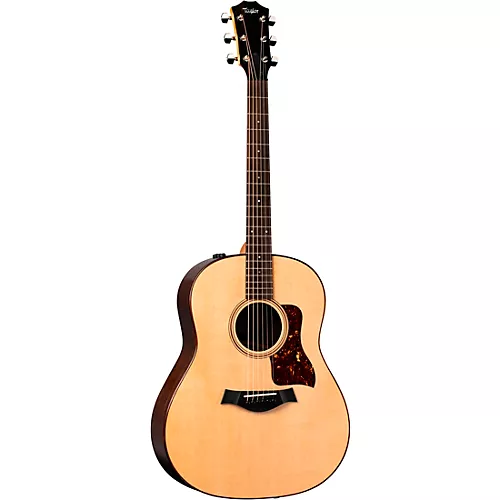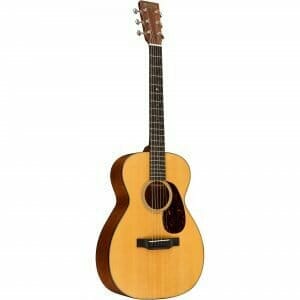If you’ve ever wondered if you should buy a concert or dreadnought acoustic guitar but can’t make up your mind, you’re in the right spot.
This article will shed light on the dreadnought vs. concert debate and help you make an informed decision based on your musical needs.
Let’s get started!
TL;DR: The Winner Revealed
So if you want the quick answer to the dreadnought vs. concert acoustic guitar debate, then, like most things in life, it depends.
This may not be what you’re looking to hear, and you want a definitive answer so you can decide and continue playing guitar. But there are lots of things to consider between the two body styles.
Fortunately, there are enough differences between the two. After spending about 10 minutes reading this article, you should be able to decide which is the best choice for you.
What Are Dreadnought Acoustic Guitars?

We will first dive into the most popular acoustic guitar body shape, the dreadnought. The dreadnought guitar was designed by C.F. Martin Guitars in 1916. It was a response to the need musicians had to be heard over other loud instruments like banjos and fiddles.
The term “dreadnought” refers to a British Battleship known for speed and power.
Power and projection is a great way to describe the sound of a dreadnought acoustic guitar. So if you’re finding yourself playing along with other musicians, then dreadnought acoustic guitars are the body style you should consider.
While Martin Guitars was the one to invent the dreadnought body shape, almost every other guitar brand has followed suit. It has a dreadnought in their acoustic guitar lineup.
The Good
Now that we had a brief history lesson on dreadnought guitars let’s dive into all the great things about this design style.
- Loud – Dreadnought guitars have a large body that produces a resonant and full-tone instrument with rich overtones. Because of the larger body, a dreadnought guitar projects sound and can easily cut through a busy mix of other instruments. This makes them great stage acoustic guitars.
- Good low-end response – The larger body shape helps produce a rich and powerful low-end response. Playing a dreadnought acoustic guitar is fun as you can feel the power push back into your abdomen.
- Versatile – A dreadnought guitar is an all-rounder. You can use it for strumming, flatpicking, fingerstyle, and even slide-playing. It also crosses genres and can be seen in the hands of country, blues, folk, rock, and bluegrass musicians.
- Excellent sustain – Because of the larger body, a dreadnought guitar has great note sustain. This is highlighted when playing big open cowboy chords.
- Wide dynamic range – Dreadnought guitars are often paired with spruce tops and have fantastic dynamics. As a player, you’ll be able to dig into the guitar, and it will continue to open up without sounding “blown out.”
The Bad
And now, let’s discuss the not-so-good.
- Unbalanced Frequency Response – Because of the dreadnought guitar size, the low-end and midrange can overpower the higher frequencies. This results in a guitar that has less note separation and can sometimes sound muddy.
- Big and Bulky – Dreadnought guitars may be too bulky for smaller players and children. Also, if you have smaller hands, consider a concert guitar with a smaller scale length and nut width.
- Not easy to play past the 12th Fret – If you go with a classic dreadnought with no cutaway, reaching the upper frets is difficult. If you want more performance out of your guitar, you will need to purchase one with a cutaway. However, with a cutaway body, you may lose some of the low end that defines the dreadnought sound quality.
- It’s Loud – Because dreadnoughts are one of the most powerful acoustic guitars on the market, they don’t make great apartment instruments. Unless you have neighbors, family, or roommates who never get sick of hearing you practice, a dreadnought may not be the best acoustic guitar for at-home use.
The Best Dreadnought Guitars to Check Out

Martin's D-28 acoustic guitar offers an iconic rich tone with powerful projection, perfect for stage and studio performance.
Quality craftsmanship is paired with vintage appointments and a modern neck profile for improved comfort and playability. Make a statement with the classic dreadnought sound of the Martin D-28!

The Fender CD-60S Dreadnought is the perfect guitar for beginners, offering a big, full-bodied sound with excellent projection for unplugged performances and practice.
So take up your journey towards mastering the guitar with this heavy-duty dreadnought.

The perfect modern dreadnought acoustic guitar, boasting solid spruce, walnut, mahogany tonewoods, and V-Class bracing for warm bass, chimey top-end, increased volume and sustain, improved intonation, and added overtones.
The AD17e combines high-quality craftsmanship and affordability, making it a must-have for acoustic players.
What are Concert Acoustic Guitars?

Concert guitars are small-sized acoustic guitars that can be considered a classical guitar with steel strings. They share a very similar body shape and produce a more delicate and focused sound, perfect for at-home practice, fingerstyle players, recording artists, and beginner guitarists.
While concert guitars don’t have as interesting of a history as the dreadnought, the players that gravitate towards these body types often have a playing style that uses complex chords and lead lines where they want each note to maintain articulate.
The Good
Now let’s dive into all the great things about the concert guitar body style.
- Articulate and Balanced Tone – Concert guitars have a more pronounced taper in the waste and rounded contours. Combined with the smaller body design, this produces a balanced frequency response. This gives concert-style guitars excellent note separation, which is great for advanced chord voicings.
- Great for recording – The clarity of notes that pinched waste concert guitars produce make them fantastic recording guitars. The less-pronounced low-end and even high-end capture acoustic guitar players’ nuances and detail without over-coloring the notes.
- Lighter weight – Concert acoustic guitars are the perfect companion for any guitar player. Not only are they small and snug, making them comfortable enough to play for hours – but their lightweight design makes them easy to travel with.
- Excellent for fingerstyle – The focused, punchy, and articulate tone of concert guitars makes them fantastic for fingerstyle guitar playing. Also, because a concert guitar takes less force to resonate, you can get these instruments to sing with a light touch.
- Great for singer/songwriters – Singer-songwriters benefit from a concert body guitar because of the intimacy and lower volume. Unlike dreadnoughts, concert guitars are easy to sing over without any amplification.
The Bad
And now, let’s discuss the not-so-good.
- Less Projection – If you’re looking to play alongside other musicians or solo playing a live gig, the lack of projection of a concert guitar will make it hard to be heard.
- Lack of low-end response – A concert guitar has a more “dainty” feel and vibe to the sound. There is a lack of power compared to the dreadnought shape that concert acoustic guitars can’t compete with.
- Small Size – This smaller acoustic guitar shape may feel cramped and uncomfortable for bigger players or those with large hands.
- Not as much sustain – Due to the smaller body size, concert guitars have less resonance and note sustain than a dreadnought.
What about the Grand Concert Guitar?

The grand concert (or “00” in Martin language) is a more modern and versatile concert acoustic guitar. They maintain all the great things about a traditional concert guitar but provide added power and projection.
Grand concert guitars have a lower bout, giving them more volume and low-end response than their smaller counterparts.
The Best Concert Acoustic Guitars to Check Out

A faithful recreation of Guild's iconic first guitar. This solid mahogany acoustic guitar has a warm vintage vibe that oozes authenticity whether you're playing fingerstyle or flatpicking.

The Yamaha FS800 concert acoustic guitar is an ideal choice for beginners. Its concert body provides a comfortable playing experience.
Its solid spruce top with nato/Okoume back and sides offer crisp highs, excellent midrange, and balanced low tones - perfect for bluegrass, folk, and country.
FAQ
Is a dreadnought or concert better for beginners?
Most beginner guitar players find a concert acoustic guitar easier to play. Also, the smaller body styles will be more comfortable for younger players and those with smaller frames.
However, players with larger frames may prefer the size of a dreadnought.
Should I buy a cutaway or a non-cutaway?
This depends on the type of playing style you want to pursue. Cutaways provide more access to the higher frets and are great for modern players who want to play scales and chords up the neck.
Also, a cutaway affects the overall tone of an acoustic guitar. It will reduce the instrument’s bass response, creating a more balanced tone.
Cutaway acoustic guitars also tend to be more expensive than a non-cutaway, and you lose a bit of “vintage charm” with a cutaway.
The Bottom Line
So there you have it, a concert vs. dreadnought acoustic guitar showdown for the ages! As you can see, one isn’t necessarily better than the other; they are simply different. You have to consider what your use case will be with your new guitar.
If you’re a beginner, a concert body style may be the clear winner in this dreadnought vs. concert debate. However, let’s say you plan on gigging out and playing with other musicians; then the dreadnought would be the clear winner.
Whatever musical styles you plan on playing, I hope this article has helped solidify the clear winner in your mind.
Thanks for reading, and happy playing!


